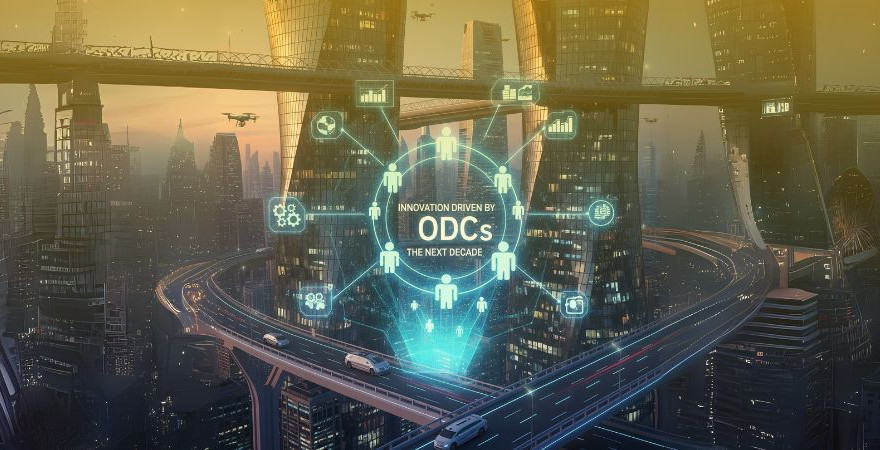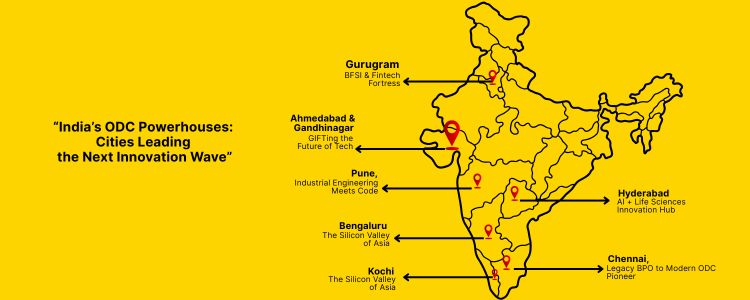
The Offshore Development Centre (ODC) has developed from the simple corporate back office and become important nodes in the enterprise innovation networks. According to NASSCOM, 72% of global CIOs consider ODC as a major contributor in digital changes and product innovation. India is at the center of this development. With IT exports of over $250 billion in FY 2024 and the operation of more than 1,900 global capability centers (GCC) in the country, India is no longer a distribution market; it is a strategic cum-making ecosystem. Supported by government policies, smart cities, and AI-based skill development, India’s offshore development services and models now enable high-marginal innovation globally.
Older beliefs prevent many businesses from exploiting the full potential of the offshore teams. Let’s break these myths from the actual world insight. This information proves that ODCs have turned into active innovation partners from reactive functioning operators.
Future of offshore development has gone beyond its cost-saving heritage. Modern ODCs, especially those located in India, now serve as the center of engineering excellence, innovation, and agile product development. Enterprises are growing rapidly towards setting up ODC in India not only to reduce costs but also to speed up product speed and digital innovation. According to a 2024 Global Outsourcing and Transformation Report: This growth supports India’s strong ecosystem:
As we enter the next decade, the Offshore Development Centre (ODC) will no longer be seen as auxiliary tasks; they will be an integral part of the enterprise, having a wide innovation strategy. The future of offshore development is not only about writing code at low cost; It is about incorporating emerging techniques such as co-production of digital products, GenAI, and intensifying the time of arrival in the market through engineering-based innovation.
GenAI Integration: The future ODC, Gen AI will be responsible for integrating the AI in the main commercial workflow, automating processes, improving the interfaces, and furthering the forecast analysis. Examples: Creating an AI co-pilot or material engine for marketing teams for enterprise applications. Product Ownership and Co-Development: Companies are fast handing over the responsibilities of product life cycle to ODC teams. This includes ideas, UI/UX, architecture, development, testing, and alignment of going to the market. IP Construction and Research and Development Centre: ODCs are filing patents, making proprietary platforms, and developing industry-specific solutions for healthcare, BFSI, retail, and other areas. Many global companies set up ODCs in India and use them not only as distribution centers, but also as digital product laboratories. Sustainable Engineering: Along with increasing ESG demands, future ODCs will also focus on green coding, carbon-conscious cloud solutions, and energy-efficient infrastructure. Cross-Functional Teams: Traditionally isolated ODC teams will develop into multidisciplinary squads, which will include AI engineers, cloud architects, product managers, UI designers, and domain consultants—all located and tight together.
India’s rise as the world’s digital engineering capital is not accidental; it is inspired by the strategic mix of economics, talent, and policy benefits. Economic and Strategic Benefits of Establishing ODC in India: For companies wishing to install ODCs in India, this time is ideal. India is no longer a distribution center – it is the launchpad of global innovation.
The coming decade will reward companies that will redefine their ODC as strategies from service branches. As digital disruption will faster, it will lead the ODC in tech innovation, GenAI, Cloud-Environment Platform and Customer Experience Design.
Inductus GCC a reliable GCC and offshore development service provider in India, is seeing a clear change. Enterprises are now choosing India not only to save costs but also for future co-construction of digital products. If you are planning your next step, the time has come to think beyond outsourcing. It is time to invest in ODC designed for agility, innovation, and development.
An innovation-first ODC focuses on product growth, AI/ML integration, platform modernisation, and co-construction of IP, which serves as a strategic branch of the enterprise. Traditional ODC costs were focused on savings and function execution. Future ODC enterprises will promote innovation, produce the product roadmaps, and lead digital changes using state-of-the-art techniques such as Genai and Cloud-Environment Architecture. BFSI, healthcare, retail, automotive, logistics, and technical fields are taking advantage of ODC for digital changes, AI, and customer-focused product innovation. The roles include GenAI engineers, cloud solution architects, product owners, full-stack developers, UI/UX designers, devops lead and data scientists. Yes. With the correct GCC consultation partner, organisations can give new form to their ODC structure, redefine KPIs, upskill teams, and align the center with enterprise innovation targets. Aditi, with a strong background in forensic science and biotechnology, brings an innovative scientific perspective to her work. Her expertise spans research, analytics, and strategic advisory in consulting and GCC environments. She has published numerous research papers and articles. A versatile writer in both technical and creative domains, Aditi excels at translating complex subjects into compelling insights. Which she aligns seamlessly with consulting, advisory domain, and GCC operations. Her ability to bridge science, business, and storytelling positions her as a strategic thinker who can drive data-informed decision-making.
Breaking Conservatism About ODC
Myth
Reality in 2025 and Beyond
ODCs are set up only for low-cost execution.
These ODCs are fueling engineering at the heart, development of digital products, and re-architecture of platforms today.
Business Process Outsourcing does not have any strategic value.
Present-day BPOs have AI/ML workflows that allow decision intelligence and CX change.
Offshore teams are mere implementers; they do not think.
Over 58% of India-based ODCs co-lead product roadmaps with HQs.
Language and cultural gaps limit creativity.
Cross-border agile squads, near real-time collaboration tools, and cultural immersion programmes bridge this.
ODCs can’t align to rapid market pivots.
ODCs now adopt agile at scale, enabling biweekly releases and continuous innovation sprints.
Offshore teams struggle with domain expertise.
India’s ODCs now house domain-certified talent in BFSI, Healthcare, Retail, and Embedded Tech
From Efficiency to Engineering Excellence
Innovation In ODC
Major Development:

Outcomes of Innovation-First ODCs:
Innovation Focus
Strategic Outcome
GenAI & AI Engineering
Smarter, faster, scalable digital solutions
Cloud-Native Architecture
Accelerated platform modernisation
IP Development
Competitive advantage and long-term enterprise value
Agile, Full-Stack Teams
Reduced time-to-market and higher product maturity
CX-Centric Design
Better user experience, higher engagement, stronger retention
Why Does India Become an Ideal ODC Destination?
Conclusion
frequently asked questions (FAQs)

Aditi
Hey, like this? Why not share it with a buddy?
Related Posts
Recent Blog / Post
- The Legal and Compliance Checklist for a New GCC Setup October 4, 2025
- The Rise of Niche GCCs: A Focus on Specialised Capabilities October 4, 2025
- The Impact of Regulatory Changes on GCC Operations October 4, 2025
- Cybersecurity for GCCs: A Proactive Approach to Data Protection September 30, 2025
- Beyond Cost: Measuring the True ROI of Your GCC Investment September 29, 2025
- The Future of GCCs in the Retail Sector: A Strategic Playbook September 29, 2025
- David vs Goliath: Mid-Sized GCCs Quietly Outperform the Big Brands September 29, 2025
- Infineon’s Big Bet on India: Inside Its First GCC in GIFT City September 29, 2025
- From Campuses to Capability Centres: How Indian Universities Power the Global GCC Ecosystem September 29, 2025
- Retail Meets Digital: Costco’s GCC in Hyderabad Marks a Global Shift September 29, 2025
- The Silent Crisis: Why Many GCCs Plateau After 3 Years and How to Avoid It September 24, 2025
- Germany’s New Skilled Immigration Act and Its Ripple Effect on the GCC Talent Model September 24, 2025
- From Tokyo to Hyderabad: The Future of GCCs for Japanese Conglomerates September 23, 2025
- GCCs as AI Acceleration Hubs: Collaborating with US and Nordic Tech Majors September 19, 2025
- Breaking the Tech Ceiling: How Women Leaders Are Reshaping India’s GCC Landscape September 19, 2025
















